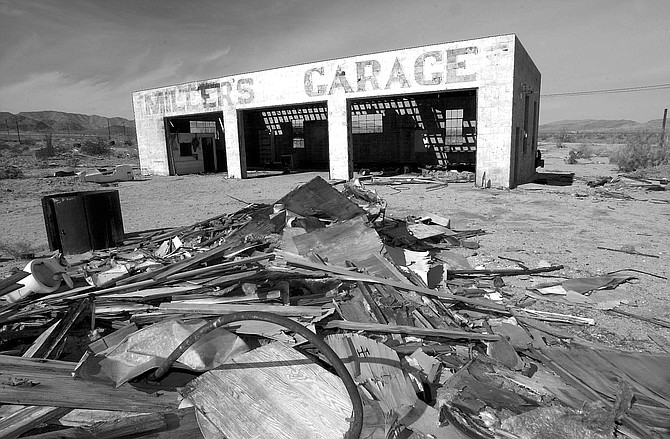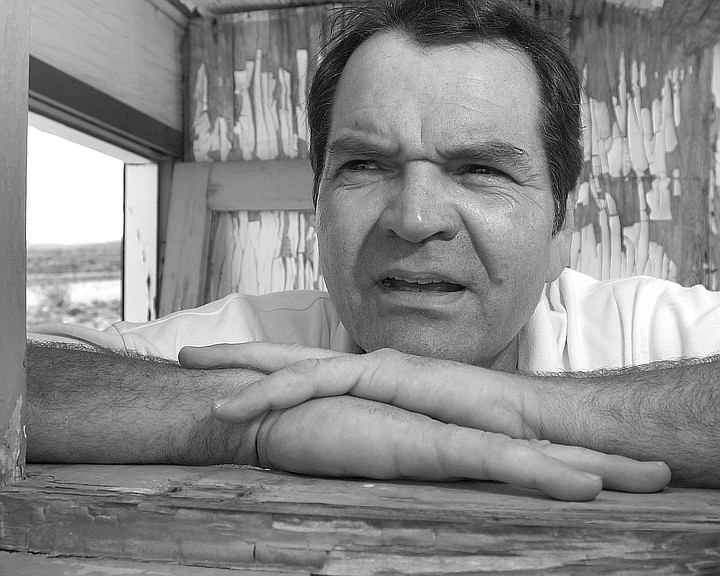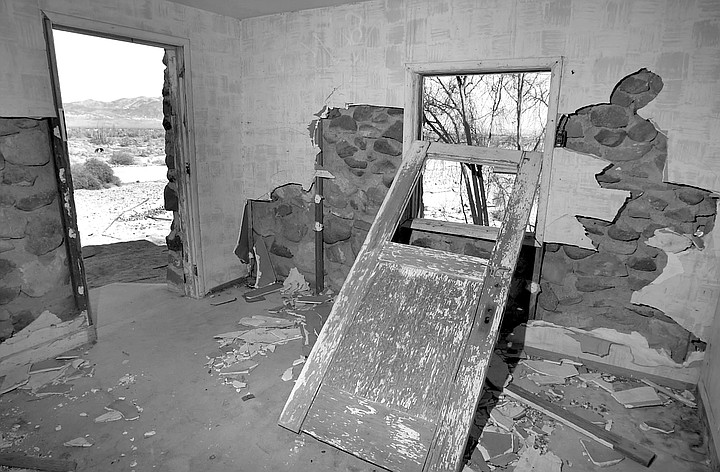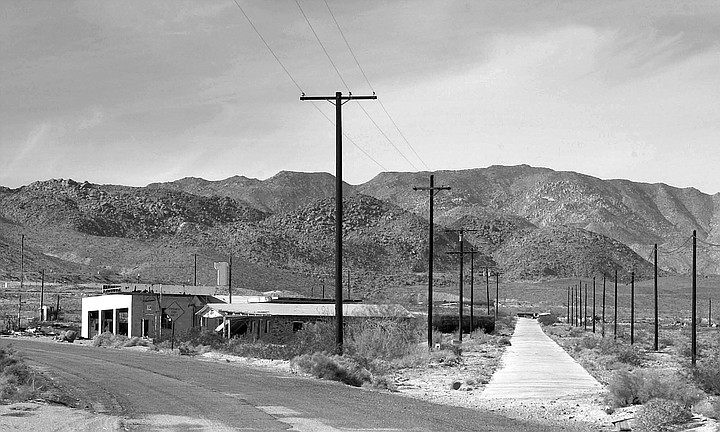 Facebook
Facebook
 X
X
 Instagram
Instagram
 TikTok
TikTok
 Youtube
Youtube

Drive east out Interstate 8 through the mountains and down the long, winding grade into the desert, and the first manmade structures you pass after crossing into Imperial County will be a cluster of four dilapidated buildings off to the left. "This is Miller's," says Bob Caldwell, a Lakeside contractor who has purchased the buildings and the four acres of desert they sit on. "It was Miller's Cafe, it was Miller's Texaco, it was Miller's! It appears on a number of old period maps as if it were a town."

But it wasn't a town. The compound was once owned by Al Miller, a Texan who moved to this area in 1926, first working for a garage up the hill in Jacumba, then opening his own roadside restaurant and garage -- and later a gas station -- just west of Ocotillo in 1933. There's no exit for Miller's from Interstate 8. The compound dates back to when U.S. Highway 80 was the road linking San Diego with the Imperial County and, ultimately, coastal Georgia.

A mile east of Miller's there is an exit for the town of Ocotillo, also on the north side of the freeway. By exiting there, and doubling back on Old Highway 80, you can reach Miller's. In the early 1970s, travelers on the newly completed interstate found this detour inconvenient, Al Miller's business became unprofitable, and the compound was abandoned.

As you approach Miller's from Ocotillo, just before you reach the oldest and easternmost structure -- a river-rock house with a low-pitched roof -- a narrow, cement roadway splits off to the right on a perfectly straight path to the horizon. "That's the older, old Highway 80," Caldwell explains, "dating from 1915."
It's the newer Old Highway 80, built in 1932, that Miller's fronts. A visit to the site reveals two things: the buildings are in better shape than they appear to be from the interstate, but the mess of rusted car parts, broken timbers, old refrigerators, and twisted sheet metal surrounding the buildings looks even worse from close range. Yet Caldwell beams with pride as he walks up to the rock house that once served as a roadside diner. A tall man in his late 40s, with dark hair and a tanned face, Caldwell reminds you of a film star you've seen a hundred times but can't name. Standing under a wooden awning sagging in the middle due to a missing post, he pauses to think when asked what inspired him to spend $25,000 to buy the place. "I like it," he says finally, "I don't care what condition it's in. I like it the way it is."
Seeing that this answer hasn't satisfied his interviewer, Caldwell explains further, "I spend most of my free time reading history. I have read some of the highway history, and this place is part of that. And I have spent most of my life working on buildings; that is what I do. So...I don't know -- here are some buildings that need work." To the left of the old café, as you face it, stands an old gas station. Its metal awning is collapsed on one side, thanks to a few stolen six-inch-thick metal posts. Beyond that stands a wood-framed utility building and finally, westernmost in the compound, stands the block-walled garage. Faded four-foot-tall letters painted above the three service bays spell "MILLER'S GARAGE."
Leaving the shade of the awning, Caldwell begins walking around in front of the buildings, heaping pieces of scrap metal and old wood into separate piles in front of the gas station. "I have an 85-year-old mother who lives alone in Phoenix," he explains as he works. "I try to see my mom about once a month. This is really why I ended up buying Miller's; I have been passing by it for so many years. There was never a For Sale sign on it. Who would want it? But I finally took it upon myself to go down to the county recorder's office in El Centro and looked up the owner of record. I wrote them a letter saying, 'Hi, my name is Bob Caldwell....' That was in the fall of 2000."
The owners, B.C. and Velma Weaver of Alpine, were happy to sell. They agreed to take 10 percent of $25,000 down and carry the rest as a loan. "No one else had ever wanted it," Caldwell explains.
Though it began happily, two and a half years later, the transaction is still not complete. Rural land purchases generally take more time than urban lot purchases because property lines aren't clearly defined. And in addition to that, there were environmental issues, such as the underground gasoline tanks. "They were filled with sand in the '60s," Caldwell explains, "which was legal for the time period. It took a while, but the county has accepted that they are legal."
Another major snag was that the wrong parcel was recorded by the First American Title Company, which was handling the sale. "They recorded an adjoining parcel," Caldwell moans. "Wonderful. Thanks very much. No one noticed -- my own attorney hadn't noticed, their attorney hadn't noticed, title and escrow hadn't noticed."
Caldwell discovered the error in November of last year while on the way to Phoenix. "I came by here and saw the tattered remains of a notice of zoning noncompliance with building codes, posted on one of the buildings," he says. "Mind you, escrow closed September 24, but I had received no copy of the condemnation. So I called county and I said, 'What is this about?' and they said, 'Who are you?' "
"We informed him," says Imperial County planning director Jurg Heuberger, "that, according to our records, which triggered a review, that showed that he, for lack of better words, thought he bought the parcel but in fact had been given a different parcel by the seller. That required him to go back to the sellers and try to get things square. And, as of today, he has not submitted anything to us to indicate that he's actually got title to the property."
Caldwell and Heuberger met in December. "I stated my intention that I wanted to refile for rezoning," Caldwell says. "He said that was fine, 'You will be working with this individual, and these are the fees, and this is the planning schedule.' He told me all of this. Then, a couple weeks later after that, I got the demolition order."
The demolition order, signed by Heuberger, stated that the buildings on the site would be razed unless they were brought up to compliance with building codes. "It was dated December 2," Caldwell claims. "Our meeting had been on December 3. And he made no mention of a demolition order at that meeting. The certified mail records show that it was not mailed from El Centro until 11 days later, the 13th. I can't help but to wonder if it even existed December 2, which I doubt."
"That property," Heuberger counters, "was actually condemned nearly a year ago, much before we ever knew he existed, and certainly before he ever bought it. When we met with him, we told him what the situation was, and we told him that we were going to continue on with the condemnation, but we would certainly be able to give him some time if he were indeed the owner."
Heuberger adds, "There's no doubt that the sellers knew that it was condemned because they actually filed an appeal on the first condemnation notice, then withdrew it."
Caldwell also has filed an appeal. "But we can't honor it until such a time as he's actually the owner," Heuberger explains. "When that happens, we would commence the appeal on the condemnation. It would go to the building board of appeals."
But Caldwell proving ownership won't necessarily save Miller's from the wrecking ball. He'll have to submit plans for renovation, Heuberger says, and they'll have to be enacted quickly. "There will be time limits," he says. "And then there's the land-use issue."
Within the past decade, that area of the desert was rezoned by Imperial County as residential. Therefore, the restaurant, gas station, and service garage that once flourished on this site would be against current zoning. "That area was there prehistorically, so to speak," Heuberger says, "before a lot of the ordinances and zoning. But it's been zoned for residential use for about seven or eight years now. But he could always apply for a zone change or something like that." And, after he's proven ownership, Heuberger says he's going to need to see some definite plans for the place from Caldwell before he stops the demolition. "He's mentioned some things, but they've not been solid," he explains. "He hasn't even sent a letter that says, 'I'm going to make this a retreat or a gas station' or anything else. It's just, 'Well, I'm going to get the house restored, I'm going to redo the garage, I may do an RV storage compound, I may do this, I may do that.' We said, 'Well, first of all, it's got to be in the right zone regardless of what you do.' "
Caldwell complains that the rezoning of what is -- other than the Miller's compound -- open desert "seems so capricious and arbitrary." He uses the same words to describe the decision to raze a compound that has stood abandoned for 30 years.
"Well," Heuberger responds, "it's just gone downhill. Two years ago, that garage was virtually intact. I went out there personally about a year and a half ago, and I looked at that garage, and I thought if somebody came out here and cleaned the rest of the mess up and put a little bit of money into fixing the doors and the windows, the rest of the building was pretty good for a storage or garage-type building. But in the last 12 months the thing has been totally destroyed. It's also an attractive nuisance for migrants and people using the property for all kinds of purposes. It's a combination of being an eyesore, a public nuisance, and in violation of the codes."


Drive east out Interstate 8 through the mountains and down the long, winding grade into the desert, and the first manmade structures you pass after crossing into Imperial County will be a cluster of four dilapidated buildings off to the left. "This is Miller's," says Bob Caldwell, a Lakeside contractor who has purchased the buildings and the four acres of desert they sit on. "It was Miller's Cafe, it was Miller's Texaco, it was Miller's! It appears on a number of old period maps as if it were a town."

But it wasn't a town. The compound was once owned by Al Miller, a Texan who moved to this area in 1926, first working for a garage up the hill in Jacumba, then opening his own roadside restaurant and garage -- and later a gas station -- just west of Ocotillo in 1933. There's no exit for Miller's from Interstate 8. The compound dates back to when U.S. Highway 80 was the road linking San Diego with the Imperial County and, ultimately, coastal Georgia.

A mile east of Miller's there is an exit for the town of Ocotillo, also on the north side of the freeway. By exiting there, and doubling back on Old Highway 80, you can reach Miller's. In the early 1970s, travelers on the newly completed interstate found this detour inconvenient, Al Miller's business became unprofitable, and the compound was abandoned.

As you approach Miller's from Ocotillo, just before you reach the oldest and easternmost structure -- a river-rock house with a low-pitched roof -- a narrow, cement roadway splits off to the right on a perfectly straight path to the horizon. "That's the older, old Highway 80," Caldwell explains, "dating from 1915."
It's the newer Old Highway 80, built in 1932, that Miller's fronts. A visit to the site reveals two things: the buildings are in better shape than they appear to be from the interstate, but the mess of rusted car parts, broken timbers, old refrigerators, and twisted sheet metal surrounding the buildings looks even worse from close range. Yet Caldwell beams with pride as he walks up to the rock house that once served as a roadside diner. A tall man in his late 40s, with dark hair and a tanned face, Caldwell reminds you of a film star you've seen a hundred times but can't name. Standing under a wooden awning sagging in the middle due to a missing post, he pauses to think when asked what inspired him to spend $25,000 to buy the place. "I like it," he says finally, "I don't care what condition it's in. I like it the way it is."
Seeing that this answer hasn't satisfied his interviewer, Caldwell explains further, "I spend most of my free time reading history. I have read some of the highway history, and this place is part of that. And I have spent most of my life working on buildings; that is what I do. So...I don't know -- here are some buildings that need work." To the left of the old café, as you face it, stands an old gas station. Its metal awning is collapsed on one side, thanks to a few stolen six-inch-thick metal posts. Beyond that stands a wood-framed utility building and finally, westernmost in the compound, stands the block-walled garage. Faded four-foot-tall letters painted above the three service bays spell "MILLER'S GARAGE."
Leaving the shade of the awning, Caldwell begins walking around in front of the buildings, heaping pieces of scrap metal and old wood into separate piles in front of the gas station. "I have an 85-year-old mother who lives alone in Phoenix," he explains as he works. "I try to see my mom about once a month. This is really why I ended up buying Miller's; I have been passing by it for so many years. There was never a For Sale sign on it. Who would want it? But I finally took it upon myself to go down to the county recorder's office in El Centro and looked up the owner of record. I wrote them a letter saying, 'Hi, my name is Bob Caldwell....' That was in the fall of 2000."
The owners, B.C. and Velma Weaver of Alpine, were happy to sell. They agreed to take 10 percent of $25,000 down and carry the rest as a loan. "No one else had ever wanted it," Caldwell explains.
Though it began happily, two and a half years later, the transaction is still not complete. Rural land purchases generally take more time than urban lot purchases because property lines aren't clearly defined. And in addition to that, there were environmental issues, such as the underground gasoline tanks. "They were filled with sand in the '60s," Caldwell explains, "which was legal for the time period. It took a while, but the county has accepted that they are legal."
Another major snag was that the wrong parcel was recorded by the First American Title Company, which was handling the sale. "They recorded an adjoining parcel," Caldwell moans. "Wonderful. Thanks very much. No one noticed -- my own attorney hadn't noticed, their attorney hadn't noticed, title and escrow hadn't noticed."
Caldwell discovered the error in November of last year while on the way to Phoenix. "I came by here and saw the tattered remains of a notice of zoning noncompliance with building codes, posted on one of the buildings," he says. "Mind you, escrow closed September 24, but I had received no copy of the condemnation. So I called county and I said, 'What is this about?' and they said, 'Who are you?' "
"We informed him," says Imperial County planning director Jurg Heuberger, "that, according to our records, which triggered a review, that showed that he, for lack of better words, thought he bought the parcel but in fact had been given a different parcel by the seller. That required him to go back to the sellers and try to get things square. And, as of today, he has not submitted anything to us to indicate that he's actually got title to the property."
Caldwell and Heuberger met in December. "I stated my intention that I wanted to refile for rezoning," Caldwell says. "He said that was fine, 'You will be working with this individual, and these are the fees, and this is the planning schedule.' He told me all of this. Then, a couple weeks later after that, I got the demolition order."
The demolition order, signed by Heuberger, stated that the buildings on the site would be razed unless they were brought up to compliance with building codes. "It was dated December 2," Caldwell claims. "Our meeting had been on December 3. And he made no mention of a demolition order at that meeting. The certified mail records show that it was not mailed from El Centro until 11 days later, the 13th. I can't help but to wonder if it even existed December 2, which I doubt."
"That property," Heuberger counters, "was actually condemned nearly a year ago, much before we ever knew he existed, and certainly before he ever bought it. When we met with him, we told him what the situation was, and we told him that we were going to continue on with the condemnation, but we would certainly be able to give him some time if he were indeed the owner."
Heuberger adds, "There's no doubt that the sellers knew that it was condemned because they actually filed an appeal on the first condemnation notice, then withdrew it."
Caldwell also has filed an appeal. "But we can't honor it until such a time as he's actually the owner," Heuberger explains. "When that happens, we would commence the appeal on the condemnation. It would go to the building board of appeals."
But Caldwell proving ownership won't necessarily save Miller's from the wrecking ball. He'll have to submit plans for renovation, Heuberger says, and they'll have to be enacted quickly. "There will be time limits," he says. "And then there's the land-use issue."
Within the past decade, that area of the desert was rezoned by Imperial County as residential. Therefore, the restaurant, gas station, and service garage that once flourished on this site would be against current zoning. "That area was there prehistorically, so to speak," Heuberger says, "before a lot of the ordinances and zoning. But it's been zoned for residential use for about seven or eight years now. But he could always apply for a zone change or something like that." And, after he's proven ownership, Heuberger says he's going to need to see some definite plans for the place from Caldwell before he stops the demolition. "He's mentioned some things, but they've not been solid," he explains. "He hasn't even sent a letter that says, 'I'm going to make this a retreat or a gas station' or anything else. It's just, 'Well, I'm going to get the house restored, I'm going to redo the garage, I may do an RV storage compound, I may do this, I may do that.' We said, 'Well, first of all, it's got to be in the right zone regardless of what you do.' "
Caldwell complains that the rezoning of what is -- other than the Miller's compound -- open desert "seems so capricious and arbitrary." He uses the same words to describe the decision to raze a compound that has stood abandoned for 30 years.
"Well," Heuberger responds, "it's just gone downhill. Two years ago, that garage was virtually intact. I went out there personally about a year and a half ago, and I looked at that garage, and I thought if somebody came out here and cleaned the rest of the mess up and put a little bit of money into fixing the doors and the windows, the rest of the building was pretty good for a storage or garage-type building. But in the last 12 months the thing has been totally destroyed. It's also an attractive nuisance for migrants and people using the property for all kinds of purposes. It's a combination of being an eyesore, a public nuisance, and in violation of the codes."
Comments